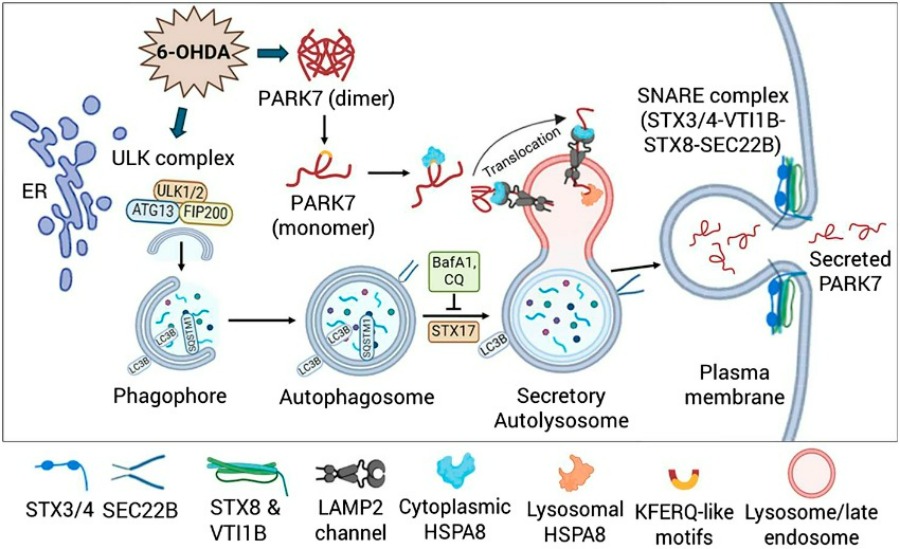Spotlights
[Research News] Autophagy and Lysosomal Pathways Orchestrate Unconventional Secretion of Parkinson’s Disease Protein
Dr. Biplab Kumar Dash, Professor Yasuomi Urano, and their research team have uncovered a novel secretion mechanism of an unconventional Parkinson’s disease-related protein mediated by autophagy and secretory autolysosomes.
Proteins are conventionally trafficked and secreted extracellularly via the endoplasmic reticulum-Golgi pathway. Some proteins that bypass this system and use unconventional mechanisms to exit the cell have been implicated in neurodegenerative diseases, inflammation, and cancer. Researchers have elucidated a novel role of autophagy mediated by the formation of “secretory autolysosomes” in the release of PARK7—a protein associated with Parkinson’s disease (PD). Their findings uncover potential pathogenic mechanisms, early biomarkers, and therapeutic targets.
Reference
Biplab Kumar Dash, Yasuomi Urano, Yuichiro Mita, Yuki Ashida, Ryoma Hirose, Noriko Noguchi, Unconventional secretion of PARK7 requires lysosomal delivery via chaperone-mediated autophagy and specialized SNARE complex, Proceedings of the National Academy of Sciences, 2025, Vol. 122 No. 19
DOI :10.1073/pnas.2414790122
https://research.doshisha.ac.jp/news/news-detail-76/
https://www.doshisha.ac.jp/news/detail/001-26Qmmn.html
https://www.eurekalert.org/news-releases/1084893

Image title: Proposed model of 6-OHDA-induced autophagy-based unconventional PARK7 secretion.
Image caption: Oxidative stress induced by 6-OHDA stimulates autophagy flux, which enhances STX17-mediated autolysosome formation, leading to the degradation of autophagosomal contents. However, in response to autophagy promotion by 6-OHDA, a subset of autophagosomes recruits ERGIC R-SNARE SEC22B. The KFERQ-like motifs of monomeric PARK7 selectively bind to HSPA8 chaperones and are recruited to the lysosomal membrane, followed by translocation into the lysosomal lumen via the LAMP2 channel. A pool of PARK7-containing lysosomes fuses with SEC22B-containing autophagosomes to form secretory autolysosomes, which then fuse with the plasma membrane mediated by a unique QabcR–SNARE complex comprising STX3/4, VTI1B, STX8, and SEC22B, releasing PARK7 into the extracellular matrix.
Image credit: Dr. Biplab Kumar Dash from Doshisha University, Japan
Source link: https://www.pnas.org/doi/10.1073/pnas.2414790122
License type: CC BY-NC-ND
Usage restrictions: Credit must be given to the creator. Only non-commercial uses of the work are permitted. No derivatives or adaptations of the work are permitted.
| Contact |
Department of Research Planning Telephone : +81-774-65-8256
|
|---|
Category
- Doshisha University Official Website:
- Top Page /Research /International /Current Student /Alumni Student /